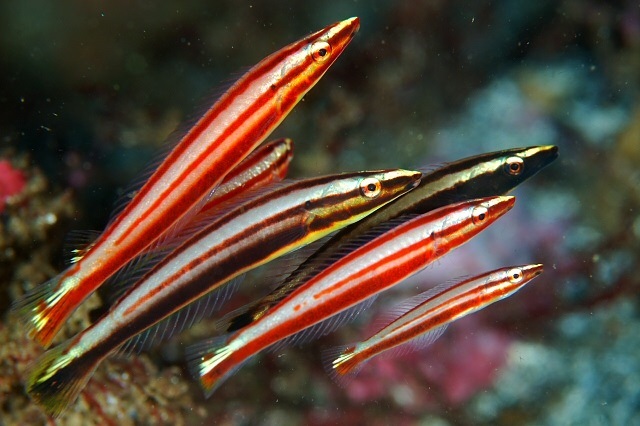Hologymnosus doliatus


| Latin name | Hologymnosus doliatus - (Lacepède, 1801) |
|---|---|
| Local name | Pastel ringwrasse |
| Family | Labridae - Hologymnosus |
| Origin | East Indian Ocean, West Indian Ocean, Australia, Japan, Indonesia, East Pacific, Central/West Pacific |
| Max length | 50 cm (19.7") |
| Minimum volume |
1500 l (396 gal) |
|---|---|
| Hardiness |
Average |
| Suitable for aquarium |
Suitable with care |
| Reef safe |
Reef safe with caution |
| Aggressiveness | Peaceful |
| Recommended |
Fish Larger crustaceans (Shrimp, crabs...) Other invertebrates Small crustaceans (Krill, mysis, artemia...) |
|---|
This species grows very quickly if fed well.
This species is known to jump out of open aquaria.
This species likes eating snails whenever possible.
This spicies might be a threat to smaller fishes.
This species like to move rocks and sometimes corals in the search for food.
This species poses a threat towards shrimps and crabs etc., which are relatively small.
This species needs a very large aquarium when fully grown.
Exactly how big the aquarium should be is hard to say, but the size of this species is such, that it cannot normally be kept in a home aquarium.
This species is very sensitive during transportation and acclimatizing into the aquarium.
This species needs a minimum of 2 inch (5 cm) of sand in the aquarium bottom, so it can dig itself down when afraid or needing to sleep.
This species revels in swimming and requires an aquarium with ample space.
Several specimen of this species can coexist in the same aquarium, provided they are introduced simultaneously.
This species can change gender from female to male.
When a male is needed, a female changes sex and takes on the role.
Hologymnosus species are very active and relatively large, they therefore need a lot of space. Has one space enough, these fish are well suited to aquarium life.
They cannot crush prey like many other Wrasses, but eat a range of invertebrates and fish, as long as they can be swallowed whole. Occasionally they can be observed smashing up their prey on rocks, into smaller pieces.
They dig themselves into the sand when feeling threatened or needing to sleep. When they are transported without sand in the container, they can sustain injury around the mouth. When selecting fish in the shop, this must be checked for.
Wrasses are nearly always seen in reef aquaria, since many of the species are both attractive and useful in battling a range of unwanted invertebrates like i.e. flatworms, pyramide snails.
These fish live of everything from zooplankton to large crustaceans, sea urchins and the like.
The needs and behaviour of Wrasses vary greatly, so it is vital to familiarize oneself with the specific species before buying one.
| Aquarium trade | Yes |
|---|---|
| Distribution | Indo-Pacific: East Africa south to southern Natal, South Africa (Ref. 4392) and east to Samoa and the Line Islands. |
| French common names |
Labre cerclé |
| English common names |
Longface wrasse Narrow-banded wrasse Candycane Pastel slender wrasse Pastel ringwrasse |
Bob Fenner. Genera Hemigymnus and Hologymnosus Wrasses - Wet Web Media - (English)
Scott W. Michael. 2009. Wrasses and Parrotfishes (Reef Fishes Series Book 5) - TFH Publications / Microcosm Ltd. - (English)

